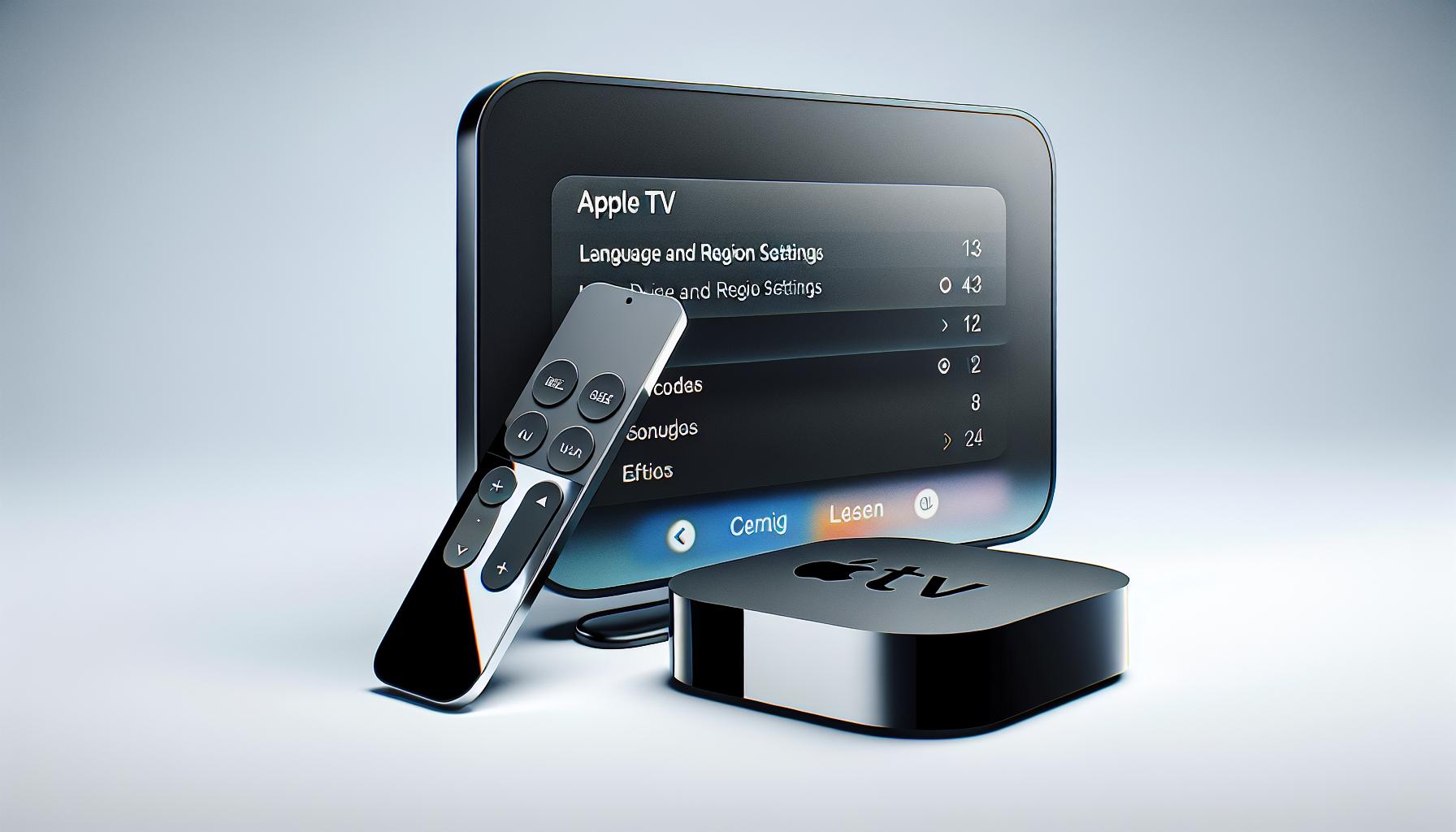Ever struggled to navigate your Apple TV because it's in a language you're not familiar with? No worries! You've landed on the right page. We're about to walk you through the steps to change the language on your Apple TV.
In today's globalized world, it's essential to have your devices set up in a language you're comfortable with. Whether you've accidentally set your Apple TV to a different language, or you're just trying to switch things up a bit, we've got you covered.
Stay tuned as we guide you through the process. It's easier than you might think! By the end of this article, you'll be able to change the language on your Apple TV like a pro.
Why change the language on your Apple TV?
Personalizing your devices is more critical in today's digital age. Every individual wants a unique and comfortable digital environment, and language plays a crucial role in this respect. After all, you wouldn't want to strain your eyes trying to understand instructions, would you?
One way to ensure this comfort is by changing the language on your Apple TV. Changing the language might sound like a trivial task, but it can make or break your viewing experience. Imagine struggling with movie subtitles or not understanding commands when navigating the menu. It can be quite frustrating.
Furthermore, the global reach of the Apple TV allows content delivery in several languages. Whether it's your preferred TV shows or top-rated films, you can enjoy them in your choice of language. There's a vast array of language options available, from English, German, Spanish to languages like Hebrew and Arabic.
Keep in mind, having your Apple TV in your native language will also make it easier for customer support to assist you with any issues you may encounter. They'll be able to guide you through the necessary steps more efficiently if they're explaining in a language you're comfortable with.
All in all, changing the language on your Apple TV does more than just enhance your viewing experience. It personalizes your device, making it an inseparable part of your home entertainment system.
In the following section, we'll guide you step-by-step through this simple process. So sit back, relax and prepare to take control of your Apple TV like never before. Rest assured, you'll master the process in no time.

Let's dive in, shall we? One of the critical steps to setting up language preferences on your Apple TV is gaining access to the settings menu. The settings menu is, in essence, the control center of your Apple TV device. Here, you'll find numerous options and controls to make your device work exactly as you want it.
To get started, you'll need your Apple TV remote. Don't worry, navigating is simple once you get the hang of it. Remember, your remote is your primary tool here.
If you look closely at your Apple TV remote, you'll notice a button labeled 'Menu'. Pushing 'Menu' takes you from wherever you are back to the main Apple TV screen. From there, look for the 'Settings' icon. It's the one that looks like a gear.
Here's a small run-through of the steps:
- Grab your Apple TV remote
- Press the 'Menu' button
- Locate the 'Settings' icon on the screen
- If you run into any trouble during these steps, don't hesitate to reach out to Apple's well-prepared customer service. They're always ready to help.
Keep in mind that the look and layout of your screen may depend on your device's model and any software updates previously installed. For the most part, the 'Settings' icon is prominently displayed for easy access. If your screen looks different, spare a moment to familiarize yourself with it. Practice scrolling and selecting until you feel comfortable.
With that, you're ready for the next step, where you'll delve into language settings on your Apple TV. You're making progress on this easy guide to making your Apple TV experience more personal and comfortable. Stay tuned for "Step 2: Navigate to Language Settings." There's more to learn as you continue reading.
Step 2: Locate the Language and Region settings

After successfully accessing your Apple TV's Settings, you've achieved the first milestone. What's next is crucial yet straightforward. You'll uncover it by navigating to the Language and Region settings.
To find them, you'll initiate a journey down the Settings menu. It's an easy path, requiring only a few well-aimed clicks on your Apple TV remote's navigation pad. As you scroll, you’ll pass through various options, each altering a unique aspect of your device.
Your destination, however, is clear - Language and Region. You'll understand its importance soon. Positioning your selection over this option will bring it to light, signalling your arrival. And don't worry if you hover over unrelated options. It'll be your Apple TV's way of filling you in on all the control you have on hand.
Remember, it's not a hidden gem - it's right there. Yes! Within the avalanche of settings, Language and Region stand boldly, waiting for you to trigger the language change process.
Here's a simplified breakdown you should find handy:
- Start your journey at Settings.
- Navigate down the menu.
- Stop when you arrive at Language and Region.
With this quick guide, you'll find yourself at the doorstep of a new language experience on your Apple TV. However, if any confusion pops up, remember Apple's customer service is always available for your queries. Thus, don't feel lost in the maze of settings - help is just a reach away. Next, we'll learn what happens once you've finally found your way to the much-awaited Language and Region settings.
Step 3: Select your desired language

After successfully navigating to the Language and Region settings on your Apple TV, you're now faced with a list of languages. This step is critical, as it allows customization of your Apple TV to better suit your cultural and linguistic preferences.
There may be numerous languages listed, making it seem a bit daunting. But don't worry, the user-friendly design and intuitive interface of the Apple system make it easy to change your device's language. You'll find everything from English, Spanish, French, German, and Italian to Chinese, Japanese, Russian, and numerous others.
To select your desired language, use the Siri Remote to highlight the preferred language. Once highlighted, press the trackpad on the Siri Remote to confirm your selection. It's as simple as that! Your Apple TV will now operate in the chosen language.
Upon making this selection, you'll immediately notice a change in the language used throughout your Apple TV interface. Expect everything from menu items, app names, and descriptions, to closed captions and system information to be displayed in your selected language. This change is swift and makes navigating through Apple TV a more comfortable experience, especially for non-native English speakers.
The ability to switch languages seamlessly is a testament to Apple's devotion to creating global, accessible technology. If you're not content with your chosen language, or if you need to switch it for someone else later down the line, you can always return to these settings. Rest assured, you're never stuck with your language choice on Apple TV.
In the case of any confusion or uncertainty while changing the language, remember that Apple's customer service is just a call away. They're available to provide assistance and answer any questions related to language preference or overall Apple TV navigation.
Now that you've selected your preferred language, it's time to understand a bit more about the Region settings. These settings further complement the language choice by altering the format of dates, times, and more on your Apple TV. In the next step, you'll delve into the Region settings to make your Apple TV experience even more personalized.
Step 4: Confirm the language change
So, you've navigated through the settings menu and managed to select your preferred language on your Apple TV. Great job! Now, it's time to confirm your changes and ensure your new language setting takes effect. Given the user-friendly design of the Apple system, even this step is a stressed-free process.
Notice a popup message? It's asking you to confirm if you're sure about the language change. Don't panic! Apple wants to be certain you're confident about your decision. So, go ahead and select 'Confirm'. It'll immediately update this setting on your Apple TV.
If, for some reason, you don't see this popup message or perhaps you've accidentally dismissed it, worry not! You can always make the change again by repeating the previous steps.
Here's the thing to remember: any changes made on your Apple TV settings will not affect your Apple ID account settings or any other Apple devices tied to it. So, rest easy knowing you're personalizing your Apple TV experience without impacting your other Apple devices.
You might be wondering why you're not experiencing immediate changes post-confirmation. Well, sometimes Apple TV takes a few moments to apply these changes and might require a system restart. Go to 'Settings', select 'System', and finally, 'Restart'. This should apply your new preferred language.
On completion of step 4, a congratulatory message might appear on your screen notifying the success of your language change. Give a pat on your back! It's rarely this easy to navigate language settings on other platforms.
The self-explanatory interface, coupled with comprehensive customer support ensures your transition to a new language on Apple TV becomes effortless. Beyond language settings, the user-friendly design extends to other functionalities too, meaning your overall Apple TV navigation experience stays responsive and personalized.
Next, we will discuss about the region settings and how adjusting them can further enhance your Apple TV experience. Now, aren't you eager to learn more?
Additional tips for customizing your Apple TV
While language settings form the core of your Apple TV customization, don’t stop there. There's a suite of settings that can further tailor your Apple TV experience to your liking.
If you have young ones, make sure to set the Parental Controls. You can limit purchase and rental permissions or restrict access to explicit content. Just navigate to: Settings > General > Restrictions.
Remember, Siri can be your best assistant while using Apple TV. It's important that Siri understands your accent and dialect. Thus, make sure to adjust Siri's language settings that suit your preferences. It can be done through: Settings > General > Siri.
Subtitles are another critical aspect for non-native English speakers or those who love foreign language cinema. Apple TV makes it easy to turn on Closed Captioning and SDH. You can also customize how they look. Navigate through: Settings > General > Accessibility > Subtitles and Captioning.
If you're a gamer, understand the importance of Game Center on Apple TV. Login with your Apple ID and you're ready to enter the world of multiplayer gaming. You can compete against friends, earn achievements and more. Setting it up is easy: Settings > Users and Accounts > Game Center.
Lastly, don't forget Privacy settings. They enable you to control what data you share with Apple and other third-party apps and services. To tweak this, go to: Settings > General > Privacy.
While Apple TV may seem like a simple utility, its customization options enable you to make it truly your own. It's more than just changing the language. These tips can help you to get the most out of your Apple TV. The step up next will elaborate on how to adapt Region settings for an enhanced experience.
Conclusion
You've now got the know-how to change the language on your Apple TV. It's as simple as accessing the settings and heading to the Language and Region settings. Remember, Apple's customer service is always there if you need extra help. But don't stop there! You can further personalize your Apple TV experience. From setting up parental controls to managing privacy settings, there's a lot more you can do. Next up, explore how adjusting the Region settings can enhance your Apple TV experience even more. So go ahead, make the most out of your Apple TV.
Frequently Asked Questions
How do I change the language settings on my Apple TV?
To change the language settings on your Apple TV, you need to access the settings menu and navigate to the 'Language and Region' option. This option is easy to find and is not hidden within the settings menu.
What other settings can I customize on my Apple TV?
Other than the language, you can also customize settings such as setting up parental controls, adjusting Siri's language settings, enabling subtitles, setting up Game Center for gaming, and managing privacy settings.
If I encounter difficulties, can I call Apple's customer service for help?
Yes, Apple's customer service is available for assistance if you encounter any difficulties.
What can I expect from the next article?
The next article will cover 'Region settings' and will focus on how these can enhance your Apple TV experience.




